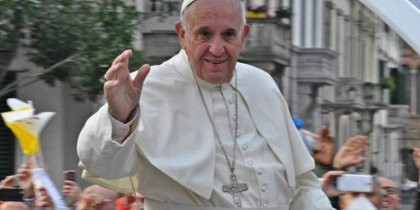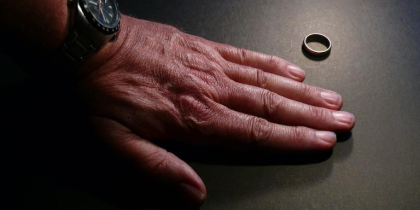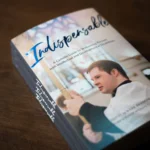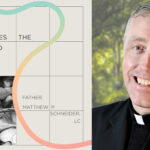On Monday, the Vatican released Fiducia Supplicans, which is a document meant to finalize any discussions of blessing gay couples and people in irregular relationships (acting like they are married when they are not). Since then, there has been a lot of media and interpolation of it. However, I think what is key with any document first is to read the document itself using a hermeneutic of continuity. This document is more about restricting any blessings that might be interpreted as thinking other sexual relationships outside of marriage are anything like marriage. After such a textual analysis, I will look at the media & the possible “spirit” or interpretations.
Sorry for the delay. Monday is community day, so I was enjoying time with my community; then, on Tuesday, some things came up; and then I started writing, and it ended up being longer than I expected.
1. FS Ends Discussion on Possible Blessings of Gay Marriage
Reading the text of the document, this is the inevitable conclusion. I will cover the main point of Fiducia Supplicans, then go section by section, and conclude this section with a note on the focus.
1.1. The Main Point of Fiducia Supplicans

The main point is that you can only bless things that will lead people toward conformity to God’s will and grace, not things that are contrary to it
The declaration begins, “This Declaration remains firm on the traditional doctrine of the Church about marriage, not allowing any type of liturgical rite or blessing similar to a liturgical rite that can create confusion.” (1) It also bans any approval by any pastor, bishop or national conference of a more ritualized blessing. (31)
The declaration says something like the following a few times, emphasizing that the blessing must be of the person, not of the “union” or “sexual relationship of the person(s): “forms of blessing, requested by one or more persons, that do not convey an erroneous conception of marriage” (26)
However, some question some later statements like “when people ask for a blessing, an exhaustive moral analysis should not be placed as a precondition for conferring it. For, those seeking a blessing should not be required to have prior moral perfection.” (25)
The distinction here of an informal blessing is important. The declaration would appear to ban any coordinated or scheduled blessings of gay couples or other types of union involving sex outside of legitimate marriage. What I think is foreseen here is more the situation where, as people are leaving Mass, multiple people come up and ask the priest to bless them or objects they have. In my experience, this is more common among those of Filipino or Latino descent than for those of northern European descent. If I say a Mass in Spanish in the USA, I can easily have half a dozen or more ask for blessings as they are leaving Mass. In such a situation, an extensive analysis is not needed. For example, if a couple asks me to bless them as they prepare for marriage, I would just give them a simple blessing, asking for God’s grace to help them prepare for marriage well, not checking about if they are cohabitating. Likewise, if a few people asked for a blessing as they go on vacation or for them to recover from an illness, I would give the blessing.
This kind of blessing after Mass or in other situations could already happen before this, and did happen. This seems to be the type of blessing foreseen by the document: “There are several occasions when people spontaneously ask for a blessing, whether on pilgrimages, at shrines, or even on the street when they meet a priest.” (28)
1.2. Brief Analysis of Fiducia Supplicans by Section
1.2.1. Section I: Marriage
Section I of Fiducia Supplicans points out the value of marriage and that nothing should be confused with it. It states, “When it comes to blessings, the Church has the right and the duty to avoid any rite that might contradict this conviction or lead to confusion… the Church does not have the power to impart blessings on unions of persons of the same sex.” (5)
1.2.2. Section II: Types of Blessings
Section II (the longest) of Fiducia Supplicans is dedicated to distinguishing various types of blessings and what they can mean. It begins by noting these are sacramentals, not sacraments. It covers blessings in the liturgy, in Scripture, and in pastoral life and theology.
It begins with liturgical blessings, which it notes: “A blessing requires that what is blessed be conformed to God’s will, as expressed in the teachings of the Church.” (9) Any blessing is asking us to conform more to God’s will in our lives. A liturgical blessing requires a degree of conformity already, as the document notes, “When a blessing is invoked on certain human relationships by a special liturgical rite, it is necessary that what is blessed corresponds with God’s designs written in creation and fully revealed by Christ the Lord.” (11)
Fiducia Supplicans (15) uses Numbers 6:24-26 as a model prayer in the Old Testament: “May the Lord bless you and keep you. May the Lord make his face shine upon you and be gracious to you. May the Lord lift up his countenance upon you and give you peace.” It shows God descending to bring us up towards his fullness in heaven. The New Testament expands on this with Jesus becoming Man in a similar manner.
The longest part of Section II is called “A Theological-Pastoral Understanding of Blessings.” The first paragraph (20) sets the tone in light with the prior two sections: “One who asks for a blessing show himself to be in need of God’s saving presence in his life and one who asks for a blessing from the Church recognizes the latter as a sacrament of the salvation that God offers. To seek a blessing in the Church is to acknowledge that the life of the Church springs from the womb of God’s mercy and helps us to move forward, to live better, and to respond to the Lord’s will.” To ask for a blessing, we need to acknowledge our need for God’s action in our lives and recognize that the Church is where this action can be found.
The next paragraph (21) hits on a similar point, “People who come spontaneously to ask for a blessing show by this request their sincere openness to transcendence, the confidence of their hearts that they do not trust in their own strength alone, their need for God, and their desire to break out of the narrow confines of this world, enclosed in its limitations.” Then the document points out the dangers of being too navel-gazing or strict legalists: this is against things like people being jerks to people in such irregular situations, which is definitely needed. We need charity, especially for those who are imperfect.
This section concludes (30), indicating “it is not appropriate for a Diocese, a Bishops’ Conference, or any other ecclesial structure to constantly and officially establish procedures or rituals” such as any official blessing of same-sex couples.
1.2.3. Section III: Application
Section III begins by repeating, “The form of which [blessings of sexually active couples not married to each other] should not be fixed ritually by ecclesial authorities to avoid producing confusion with the blessing proper to the Sacrament of Marriage.” (31) This again emphasizes this is referring to simple blessings we can give everyone, not to some rite or even to a thing that can be scheduled to invite your friends to. It repeats this a third time later: “one should neither provide for nor promote a ritual for the blessings of couples in an irregular situation.” (38)
Much of this is bringing what was previously said above into practice.
It also notes, “the pastoral sensibility of ordained ministers should also be formed to perform blessings spontaneously that are not found in the Book of Blessings.” (35) The goal is that “these non-ritualized blessings never cease being simple gestures that provide an effective means of increasing trust in God on the part of the people who ask for them.” (36) I think this is good in general apart from the specific application here. I think it is a great expression of faith to ask for blessings for relatively minor things in life, like a new job or traveling.
The document makes explicit that such a blessing cannot be concurrent with a civil union or civil marriage. (38) This is without exception.
1.2.4. Section IV: Church as Sacrament
This section simply reaffirms the teaching that the Church is the sacrament of salvation.
1.3. Focus or Development in Fiducia Supplicans
The goal of Fiducia Supplicans is more about clarifying the teaching on blessings than on gay relationships or cohabitation. The point seems to be that we cannot bless sin, but we can bless people in sinful situations.
The text distinguishes the blessing of a marriage as a sacrament, while other blessings are only sacramentals. The text does not mention absolution in confession specifically, but I think it is also valuable as an analogy for its point. We absolve people who have sinned – in fact, not acknowledging any sin prohibits absolution. The quasi matter of confession is the contrition of the penitent, which is both that acknowledgment they have sin and that desire to turn from sin – lacking the intention to avoid future sin also makes absolution impossible. However, in such a sacrament, we do not require that the person never commit any future sin, or even that they don’t commit this specific sin. A person can come to confession dozens of times, striving to overcome the same sin.
This development on blessings is to clarify that blessings are not just of good things but also of things or people striving to do good. I think this was already the practice, but clarification is good. I’m asked to pray for X’s conversion or for Y’s health all the time, sometimes including blessings, and as what is sought is a good thing, I openly give such a blessing, even if X or Y has serious publicly known sin. The fact a person comes for a blessing shows they are intent on moving towards it, unless evidence indicates the contrary. Now, if it is clear these two people want to make the appearance that God is happy with their current stable sexual relationship outside of true marriage by a blessing, that is evidence against such a blessing.
2. Media: Fiducia Supplicans Allows for Blessings of Gay Couples
The media, who did some quote mining of Fiducia Supplicans and then decided to make the headlines even more dramatic than the text, took this a very different way from what the text says on careful reading. Here are a few examples:
- AP: “Pope approves blessings for same-sex couples if they don’t resemble marriage” & “Vatican authorizes blessings for same-sex couples”
- ABC (Australian National Broadcaster): “Vatican approves blessings for same-sex couples in landmark ruling for LGBTQ Catholics”
- NPR: “Pope approves blessing for same-sex couples”
- New York Times: “Pope Francis Allows Priests to Bless Same-Sex Couples”
- BBC: “Pope says Roman Catholic priests can bless same-sex couples”
- France24: “Vatican authorises blessings for same-sex couples – under certain conditions”
- National Catholic Reporter: “Vatican shift on gay blessings has ‘deep pastoral implications,’ say theologians”
- This article includes an image directly contrary to the document on top, where a priest is blessing a gay couple in a way strongly resembling marriage.
- The Washington Post: “Vatican Says Yes to Blessings of Same-sex Unions”
- Another photo contrary to the decree set as if the decree approved it.
- NBC: “Pope Francis gives Catholic priests permission to bless same-sex couples”
- The Canadian Press: “EXPLAINER: How can Catholic priests bless same-sex unions?”
Most of these completely miss the point of the document. Some at least have some nuance, like saying “under certain conditions” or specifying they can’t resemble marriage, but most don’t have that in the headline or lead paragraph.
The problem is that most people will get their information through media like this. Documents should be clearer to avoid such confusion.
3. The “Spirit” of Fiducia Supplicans
Although the document itself is good, I think there are multiple ways it could have been clearer. Now, given the media narrative and some in the Church who want to interpret this document according to their preferences or preconceived ideas rather than the hermeneutic of continuity that Church documents should be read in.
This section will have five parts: the issue of confusion in how it was written and presented, those following the spirit and pushing the letter, those ignoring the letter and pushing a spirit directly contrary to it, some statements by those in the Church who understand the document, and conclude with how this false “Spirit” hurts the Church.
3.1. Confusion in the Wake of Fiducia Supplicans
I have a doctoral degree in theology and am particularly trained in a proper hermeneutic for reading the magisterium according to the mind of the Church. Reading the document first gave me a clear indication of the orthodoxy of the document, but at the same time, I could see how people of good-will could get a very different vision or confusion from the document. It is important for Vatican documents to emphasize clarity so an average person in the pew can easily understand or provide some kind of clarification in a simplified version as an interpretive key, so people don’t get confused.
The overwhelming attitude I see from people of good-will, such as extended family and friends, priests more involved in parishes (not teaching college theology like me), etc., is confusion. They are not sure what the document says. Parishes are getting calls they can’t fulfill from people who want to get their illicit relationship blessed in ways that are contrary to the text of the document. This is not helpful.
I get that the Vatican wanted to avoid an interpretation in the other extreme where if someone asks a priest to bless them before they go in for surgery, the priest would not bless them for that if they were sexually active apart from their real spouse. I do not think this was a big issue in the USA or Canada, but I could see it happening elsewhere. However, the document as written led to a lot of misinterpretation in the other direction.
3.2. People Following the “Spirit” of Fiducia Supplicans
The day after, The New York Times did a profile of Fr. James Martin doing a blessing of a gay couple the day after this document came out from the Vatican. The header image is Fr. Martin in clerics with his hand over two men in normal business casual clothes. Without context, I would not assume this was a couple who are civilly married (but not really married) having a blessing related to their relationship. However, in the context, this is pushing the line of what Fiducia Supplicans says: “When it comes to blessings, the Church has the right and the duty to avoid any rite that might contradict this conviction or lead to confusion.” (5) To pose for a photo like this you know will be captioned something like the actual caption is borderline to what is allowed: “The Rev. James Martin gives a blessing to Jason Steidl Jack, left, and his husband Damian Steidl Jack, center, in Manhattan.” They are not husbands in reality, yet the Catholics interviewed in this piece repeatedly use such factually incorrect language that creates confusion. For example: “I know that myself and my relationship with my husband are good things.” But this is a man who ontologically cannot have a husband: only a woman can.
Fr. Martin also did a very generic blessing you can impart to anyone. Part of it is quoted: “May the Lord make his face shine upon you, and be gracious to you. May the Lord turn his countenance to you and give you joy and peace.”
This is pushing to the edge of what is allowed, but not going beyond it.
3.3. A “Spirit” Contrary to the Letter of Fiducia Supplicans
Fr. Martin is smart enough to go to the line of what is allowed and not go over, however, I doubt that will be done by everyone. I can see other priests giving blessings that are much more marriage-like than the generic blessing he gave, and thus creating more confusion.
In fact, we already have people in the Church going directly contrary to the letter of the document. The Pillar noted two evident cases of this.
- Archbishop Franz Lackner of Slazburg claimed: “Basically, one can no longer say no.” This is directly false. The document leaves it up for a degree of local discernment with what might be considered a blessing or situation that gives the impression this is a marriage-life relationship. If two women both dressed in white wedding dresses came up and asked a priest in the USA to bless their relationship, he is obliged to refuse as anyone in our culture would interpret that in a way that implies a marriage-like relationship.
- Bishop Johan Bonny on Antwerp interpreted it as moving forward towards a formal rite which he previously endorsed. This is despite it definitively prohibiting this.
Due to the delegation of pastoral prudence down without the greatest clarity, there will likely be places that go much further. I can only imagine that some priests will use this document as a license to bless homosexual relationships in ways that are all but marriage. I am willing to bet that I will see an article in the next quarter of a case where a priest goes directly contrary to the document with something like blessing a gay couple at their civil (and not real) wedding and claiming he is following the “spirit” of the document. This is a serious danger. People will be confused when/if they see it in the news.
3.4. Good Explanation by Church Leaders
The same Pillar article also noted a bunch of other bishops, a few of which are worth noting.
- Bishop Andrew Cozzens noted that this document does not “in any way a change in the Church’s teaching about marriage.” He also noted, “Although it is impossible for us to bless a same-sex union, since any sexual union outside of the marriage of one man and one woman is contrary to the Gospel, we may bless individuals who are not yet living in full accord with the Gospel, even those in a same-sex union.”
- Archbishop Socrates Villegas of Lingayen-Dagupan in the Philippines distinguished three types of blessing: an invocation to God, a “blessing of sanctification,” and a “blessing of mercy.” He indicated that in blessing people together involved in some non-marital but sexual relationship it is a “blessing of mercy,” which cannot be “a blessing of sanctification since we cannot ask God to bless something that, as Fiducia Supplicans explains, is not ‘conformed to God’s will, as expressed in the teachings of the Church’ (no. 9).” He also asks priest to use words indicating this.
- Bishop John Folda of Fargo said similarly, noting that such blessings “are not to be confused with marriage or any liturgical rite, and may be given not to legitimize an irregular relationship, but to offer God’s grace and assistance to all who seek his healing love.”
There are several others there. I simply want to emphasize that this proper interpretation is common.
3.5. The Damage of Such a “Spirit” and the Danger of Schism
The overall result of such a spirit and such division is confusion among the faithful. In theology, clarity is charity. I hope my piece here can help contribute to clarity on this point. This confusion is not what the Church should seek.
I suspect much of the goal here is to attempt to avert a schism in Germany and the low countries over this. Their bishops’ conferences have moved towards endorsing such blessings in a ritual way. I read this as an attempt to avoid a schism, but I fear it will not do that. Some of those bishops will go ahead and create formal ritualized blessings directly contrary to this document. The prior document to them on this was pretty direct in indicating that such an approval would be schismatic, but how some will interpret the “Spirit” of Fiducia Supplicans some may feel emboldened to go ahead in acts already indicated as schismatic.
Please pray for unity in the Church. Please work for unity in truth in the Church.
4. Conclusion
Sometimes, the Vatican chooses to clarify what is already clear. It happened recently with a decree clarifying that unwed mothers can receive Communion. Likewise, Fiducia Supplicans generally just clarifies what was already Church teaching. If anything is new, it is the development of a theology of blessings, and/or more definitively shuting the door on liturgical blessing for those in publicly known sexual relationships outside authentic marriage. However, the document could have been clearer to those with less theological training.
Overall, the Vatican has maintained a clear line that “gay marriage” is a legal fiction and anything that might give an impression otherwise must be avoided. However, at the same time, we can bless persons, even if they are in such situations. I hope that the USCCB & CCCB give some more specific indications for the US & Canada specifically on what needs to be avoided, as it would likely give off the impression of endorsing such relationships. There is always some pastoral prudence at the local level, but the bishops forbidding X, Y, and Z helps priests as it gives them a secure guide when a couple wants something they prudentially think would be too likely to represent saying a non-marriage sexual relationship is marriage-like. It also avoids the priest being seen as some kind of “meanie” by people if he refuses a blessing on good prudential grounds. Such specifications should be specified at the country level, as certain symbols mean different things in different societies. For example, here, I would think a woman wearing a white wedding-like dress to get such a blessing would appear too much like marriage in the US and Canada for a blessing to be permitted, but such a white dress is not a universal sign of marriage.
Let’s continue to promote the Catholic view of human dignity and the Catholic and true view of marriage. Let’s also respect the dignity of individuals and bless them personally when it might help them and not confuse others.










Father, the NYT article on Fr Martin does mention that the couple was “married” in a different church and were living like spouses. It also mentions that Fr Martin did call them and invited them to come and receive a blessing in front of the NYT reporters. I don’t think he was trying to stretch the line, he did cross it.
Second, I hardly can believe that the problem they were trying to avoid was people being rejected from blessings because of their marital status or sexual orientation, as you stated in the document.
I read his article as a means to justify & rationalize “blessing” of same sex couples as the document clearly states. It is a document that completely contradicts the 2021 document stating such blessings for same sex unions is forbidden. One does not need a degree in theology to see that the document is a cause for confusion & further scandal. God is NOT the author of confusion. See the first reading from 12/28/23 for clarity on this word salad document; 1 John 1:5 -2:2.
I would suggest you read the document more clearly with a hermeneutic of continuity. It is not super clear so people can come away with that reading, but I think others can be more in line with the context in the Church.
Hi Fr.,
Very nice article. Thank you for writing this it is very helpful.
I have a son who is Autistic who identifies as a female. He is 23 and is mimicking trans video game characters that he discovered during the COVID pandemic.
Have you ever thought about doing an article on why so many autistic people identify as Transgender?
Would love to have your perspective on it.
Best regards,
Vince G
It is one of those things that is on my list but keeps getting pushed down.
I look forward to it. Thank you for the reply Father.